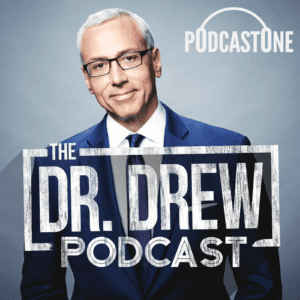The Dr. Drew Copyright Debacle
How to make a bad situation worse...

As most of the United States, and indeed much of the world, settle into various stages of lockdown over the COVID-19 pandemic, many are looking back at those that originally downplayed the virus or called it a hoax. As more and more become infected and the death toll climbs, those early predictions look worse and worse in hindsight.
One person to find himself under such scrutiny is Dr. Drew Pinsky, more commonly referred to as Dr. Drew. In the early months of the epidemic, Dr. Drew repeatedly downplayed the virus, referring to it as being little more than the flu and even called it a media-induced panic.
Those comments have not aged well and Dr. Drew has apologized for them. That said, critics of his are not eager to let him or others forget those comments and at least one person has cobbled together compilations of Dr. Drew saying such things on his various shows.
The result is a montage that looks very bad with the current state of events. However, Dr. Drew has not been sitting idly by as others criticize him. In addition to his apology he has, at least on one occasion, has used copyright law to remove a critical video.
This, predictably enough, has sparked a new round of criticism against Dr. Drew as he is now accused not just of giving bad advice about COVID-19 but abusing copyright to silence criticism.
The Story So Far
Disclosure: Though I have no known connection with Dr. Drew or his various companies, I did appear on Dr. Drew HLN back in July 2016 as part of their coverage on the Melania Trump plagiarism scandal.
On April 4, journalist Yashar Ali shared a two-minute compilation of Dr. Drew making false statements about the COVID-19 pandemic that was originally posted by Twitter user DroopsDr. That version, which is hosted on Twitter, is still online and currently has over 4 million views as of this writing.
According to Ali, DroopsDr also put together a longer version of the video and uploaded it to YouTube. However, that version is currently unavailable due to a copyright claim by Dr. Drew Inc.
If that look wasn’t bad enough, the backlash against the takedown was further stroked by a now-deleted tweet by Dr. Drew that accused someone who shared the video of violating “copywrite” laws.
This has not boded well for Dr. Drew as sharing of the Twitter version of the video has increased rapidly, with millions more now seeing it.
To be clear, Dr. Drew has apologized for his statements on the pandemic, doing so on an April 4 video. However, as others have noted, that apology rings hollow considering that, at the same time he was recording his apology video, he was also removing videos that were critical of him and threatening those that share them.
It was a bad look for the doctor, that much is certain, but was any of it illegal? That’s a thornier question.
Looking at the Law
As strange as it may seem, there’s a lot about this case that we don’t know with any certainty. The biggest is whether the video was blocked because of Digital Millennium Copyright Act (DMCA) notice or if it was through YouTube’s Content ID system.
The latter is more likely and the legality there comes down to the agreement between Dr. Drew’s company and YouTube. After all, the Content ID system is wholly a creation of YouTube and they are the sole arbiters of it. It would ultimately be up to YouTube as to whether or not this was an abuse of the system.
If it were a DMCA notice, legal precedent comes to bear but may not be very helpful for those that want to see Dr. Drew pay. A DMCA notice only requires that the filer, in this case Dr. Drew’s company, have a “good faith” belief that the work is infringing.
However, in the famous “Dancing Baby” case, the Ninth Circuit ruled that the good faith standard is subjective, meaning that it’s in the mind of the filer. This means that, even if he is wrong, as long as Dr. Drew (or whoever decided to file the notice) genuinely believed that the work was infringing, the notice is likely legal.
Even though that same case saw the court ruled that filers did have to weigh fair use when submitting a DMCA notice, the flexible nature of fair use makes it difficult to prove someone did not have a subjective belief that something was infringing when they filed.
While it may seem unfair that a person that can’t even spell “copyright” correctly gets to decide what is and is not infringing when filing a takedown notice, that’s the situation we are in.
But was the video itself infringing? Shouldn’t it have been a fair use? It’s impossible to say without seeing the full video, but looking at the shorter one, it definitely seems likely. If nothing else, a compilation of short clips for the purpose of criticizing Dr. Drew’s actions has strong fair use arguments that deserve serious weight.
To be clear, it’s impossible to know for certain how a court would rule on this as we have seen some crazy fair use rulings in the past, but I agree with attorney Leonard French that this is likely fair use.
In the end, if it was a DMCA notice, DroopsDr can file a counter-notice to get it restored (in two weeks). If it was a Content ID match, he can appeal it though, as we’ve seen before, that may be a fool’s errand.
The Real Issue
All of the discussion about the legality of the video or its takedown belies the real issue. It was neither appropriate nor wise to use copyright in this circumstance.
Even if we assume that the video was a clear infringement, the issue from Dr. Drew’s side was not copyright. Dr. Drew was not fearing loss of revenue because these clips were going to replace viewing his various shows. This was not a case of someone sharing his content in a way that would hurt his ability to capitalize on his work.
Dr. Drew was worried that the video would harm his reputation and used copyright law as a means to try and mitigate that. Even though it’s sometimes technically legal, it’s never wise.
The first reason is because of the Streisand Effect. As Dr. Drew is learning, one of the quickest ways to ensure that something is shared broadly online is to try and censor it. Such attempts to quell criticism with copyright rarely work out well.
The second is pure ethics. Copyright law is meant to be a tool that allows creators to control their creations so they enjoy the benefit from that creativity. It’s not meant to be a tool to silence criticism and fair use is part of the law specifically for that reason.
Regardless of legality, Dr. Drew’s (or rather his company’s) removal of the work was misguided and wrong, especially when he’s supposedly apologizing for the very thing he’s being criticized for.
It’s a bad look, to say the least, and it only compounds the flak he’s getting for his earlier statements and ensures that more people will see them. It’s a lose-lose for Dr. Drew.
Bottom Line
I do DMCA takedown work as part of my consulting firm, CopyByte. However, I find that I turn away as many, if not more, clients than I take on.
The reason for this is simple. A lot of people want takedowns over things that aren’t appropriate, even if they are technically legal.
Dr. Drew is an example of a client I would turn away. If he or his company came to me with this takedown, I would reject it out of hand. It is legally dubious (at best) and definitely unwise. It’s a takedown that could only make things worse.
Whether it was Content ID or the DMCA it doesn’t really matter today. The video is down and Dr. Drew is facing backlash over it. This all could have been avoided if Dr. Drew had taken his lumps and march of time cause his transgressions to be largely forgotten.
The truth is, if he had just done nothing, this likely would have blown over by now. Instead, he made a viral video of him being wrong about COVID-19 a newsworthy event.
I’m assuming that’s not the result he desired.
Top Image of Dr. Drew by: THE 1 SECOND FILM / CC BY-SA
Want to Reuse or Republish this Content?
If you want to feature this article in your site, classroom or elsewhere, just let us know! We usually grant permission within 24 hours.
